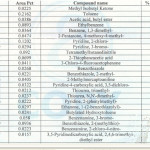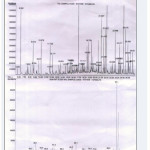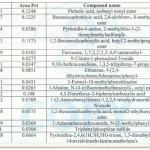Identification and Characterization of Aromatic Compounds from Ground Water in the Patancheru Industrial Development Area and its Environment, Medak District, Andhra Pradesh, India
L. K. Mahalakshmi*, Julie Thomas1, Y. Amarnadh2 and T. Vijayalakshmi3
1Environmental studies,CMRIT,Medchal,Hyderabad (India).
2Environmental Studies,St.Francis,Begumpet (India).
3Sai Adventium,Bollarum (India).
4JNTU,Hyderabad (India).
Many number of Bulk drug, and pharmaceutical, fertilizer, electroplating industries have opened since 1970’s in the Patancheru Industrial Development Area of Medak District, A.P., India. Fe industries are releasing treated and few industries are releasing untreated effluents in to the nearby Nakkavagu river, which is flowing nearer to this Area. In this paper we found nearly 60 varieties of Aromatic Compounds from the samples of effluents and various ground waters etc., Water samples from Nakkavagu are also tested and found various toxic Aromatic compounds.
KEYWORDS:Effluent; COD; Carcinogenecity; Teratogenecity
Download this article as:| Copy the following to cite this article: Mahalakshmi L. K, Thomas J, Amarnadh Y, Vijayalakshmi T. Identification and Characterization of Aromatic Compounds from Ground Water in the Patancheru Industrial Development Area and its Environment, Medak District, Andhra Pradesh, India. Orient J Chem 2011;27(1). |
| Copy the following to cite this URL: Mahalakshmi L. K, Thomas J, Amarnadh Y, Vijayalakshmi T. Identification and Characterization of Aromatic Compounds from Ground Water in the Patancheru Industrial Development Area and its Environment, Medak District, Andhra Pradesh, India. Orient J Chem 2011;27(1). Available from: http://www.orientjchem.org/?p=24839 |
Introduction
Now-a-days many people / Scientists are discussing the various pollution problems of Patancheru. Because more than 450 industries are located in and around dealing in the production of Pharmaceuticals, Bulkdrugs, paints and pigments, metal treatment and steel rolling, cotton and synthetic yarn Electroplating, casting, beverages, distilleries, and engineering goods.
CETP is situated near Peddavagu and the waste water is discharged into the Peddavagu stream from the CETP was found to have BOD more than 8000 mg/l, and also various phenolic and Arometic compounds.
Water chemistry
Water samples were collected for analysis from borewells, dugwells and surface water bodies at 10 locations.
For instance the maximum permissible limits of BOD of the waste water is 30 ppm, If it is discharged into inland waters,it is 350ppm. If discharged into a public sewer and 100 ppm if discharged on to land or coastal region (CPCB).
10 samples are tested for the BOD value and also for various Aromatic compounds.
We also tested two samples for pesticide lindane and parathion using GC-Mass Spectrography.
Instruments / Methods
Effects of water pollution on Environment: Many Borewells, dugwells and ground water sources, aquifers are contaminated with these chemicals and the Nakkavagu’s water turned brownish water more foam on surface. Many villages from Arutla, sultanpur etc., are complaining that their yields have dropped.
Many people are effected in patancheru because ground waters are contaminated by the Aromatics and phenols. The factories still releasing their chemicals water in to the Nakkavagu stream. Many times children who are playing and swimming in this river are developing rashes on skin and they are complaining burning sensation in eyes.
The major Organic compounds are
Aliphatic
Aromatic
Heterocyclic
Organo Halogen compounds- Organo phosphate compounds which also have solubility in water.
Combinational Factors
The three combinational factors are COD, BOD and inert TDS provide 8 possibilities as under
COD (H), BOD (H), TDS (H)
COD (H), BOD (H), TDS (L)
COD (H), BOD (L), TDS (H)
COD (H), BOD (L), TDS (L)
COD (L), BOD (H), TDS (H)
COD (L), BOD (H), TDS (L) H = High
COD (L), BOD (L), TDS (L) L = Low
We also calculated BOD and COD values of two samples. Sample 1 from CETP effluent before discharging in to Nakkavagu stream and another sample from a Bulk drug industry which is decomposing effluent from CETP. Both the values have largest variation. Initial BOD is > 8000 mg/l, after treated in CETP BOD value will be > 350 mg/l.
In the below table the following compounds are present indicated along with the Retention time.
Method of Test: US EPA – 846 – 8270
EPA refers to methods for chemical analysis of water and wastes.
USEPA office of Research and Development.
SW – 846 refers to test methods for evaluating solid wastes, physical / chemical methods.
The Water samples from various areas are tested by using the above method and we got the following results.
The effects of various chemicals on humans and also various materials of Environment.
Benzene present in water can seep into the surrounding soil.
Humans most often come into contact with benzene either by breathing it in drinking contaminated water, or through skin absorption.
If benzene contact with low conc; for a short time can cause headaches, vomiting, , elevated heart rate and loss of consciousness.
People who work with benzene or who are exposed to it over a long period of time are at the high risk for developing benzene – related illness which range from anaemia to cancer.
Immediate signs and symptoms of exposure to benzene in humans.
Drowsiness
Dizziness
Irregular heart beat
Headaches
Tremors
Unconsciousness
Death (At very high levels).
Direct exposure of the eyes, skin or lungs to benzene can cause tissue injury and irritation.
DHHS – has determined that benzene causes cancer in humans. Long term exposures to high levels of benzene in the air can cause leukemia, cancer of the blood forming organs.
Paint, varnishes industries use toluene.
Effects of toluene on humans
Historical reports of blood effects caused by toluene are more than benzene contamination. Liver or kidney damage is observed in many cases. Prolonged contact can cause dermatitis (dry, red skin).
There are case reports of accident ingestion of toluene causing severe central nervous system (CNS) depression and death.
The international agency for research on cancer (IARC) has concluded there is inadequate evidence for the carcinogenecity of toluene in humans.
Toluene in humans causes teratogenicity (facial aberrations, reduced growth, neuro behavioural delay, renal / urinary problems. These extreme exposures to toluene as well as other confounding factors such as tobacco and alcohol abuse are not relevant to occupational situations.
Conclusions
Basing on the findings of the toxicity of chemicals the industries must adopt treatment technologies which will not release the effluents with such toxic chemicals or else they can adopt green chemistry to reduce these toxic compounds from their effluentsand so even if they release effluents, environment is not effected as well as humans and other living creatures. The following compounds are obtained in the GC-Mass Screening ( various water samples from the above areas of patacncheruare screened and the below chromatogram is indicating the %of the aromatic compounds).
 |
Figure 1 Click here to View figure |
 |
Figure 2 Click here to View figure |
 |
Figure 3 Click here to View table |
References
- Mihelcic JR, Luthy RG: Degradation of polycyclic aromatic hydrocarbon compounds under various redox conditions in soil-water systems. Appl Environ Microbiol 1988a;54:1182–1187. Mihelcic JR, Luthy RG: Microbial degradation of acenaphthene and naphthalene under denitrification conditions in soil-water systems
- Morasch B, Meckenstock RU: Anaerobic degradation of p -xylene by a sulfate-reducing enrichment culture. Curr Microbiol 2005; 51: 127–130.
- Nales M, Butler BJ, Edwards EA: Anaerobic benzene biodegradation: a microcosm survey
- Prince RC, Suflita JM: Anaerobic biodegradation of natural gas condensate can be stimulated by the addition of gasoline. Biodegradation DOI:10.1007/s10532–006–9084–4.
- Rabus R: Biodegradation of hydrocarbons under anoxic conditions; in Ollivier B, Magot M (eds): Petroleum Microbiology. Washington,ASM Press, 2005a, pp 277– 299.
- Rabus R: Functional genomics of an anaerobic aromatic-degrading denitrifying bacterium, strain EbN1. Appl Microbiol Biotechno l 2005b;68: 580–587
- Rabus R, Fukui M, Wilkes H, Widdel F: Degradative capacities and 16S rRNA-targeted whole-cell hybridization of sulfate-reducing bacteria in an anaerobic enrichment culture utilizing alkylbenzenes from crude oil. Appl
- Text book of Environment and Ecology —Kaushik and kaushik
- Text book of Toxicology -Ernest Hodgson
- Textbook of modern toxicology —- V .V.pillay
- Environ Microbiol 1996; 62: 3605–3613

This work is licensed under a Creative Commons Attribution 4.0 International License.









